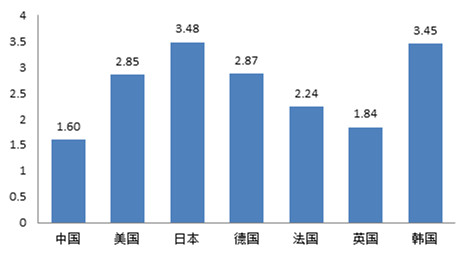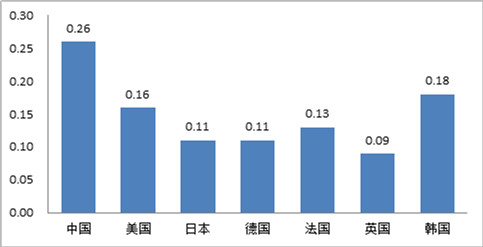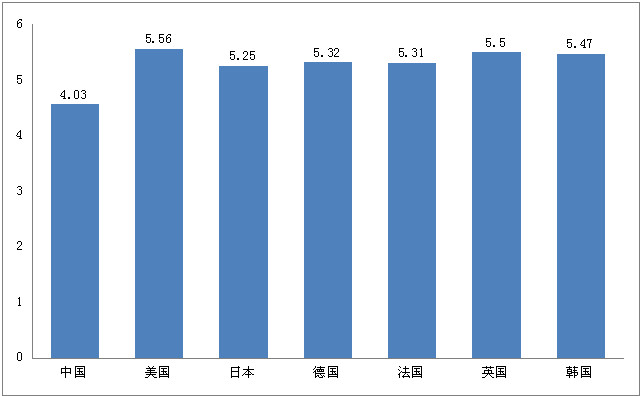Abstract After 60 years of rapid development, especially since the reform and opening founding of China's manufacturing industry has made remarkable achievements, it has become an important force to support sustained and rapid development of the national economy, and built a complete range of independent and complete industrial system, but China is still In the process of industrialization...
After more than 60 years of the founding of the People's Republic of China, especially since the rapid development of reform and opening up, China's manufacturing industry has achieved remarkable achievements and has become an important force supporting the sustained and rapid development of the national economy. It has built a complete, independent and complete industrial system, but China is still in In the process of industrialization, the problem of big but not strong is still outstanding. Compared with advanced countries, there is still a big gap. The task in the future is still arduous and urgent. Mainly in the following aspects: 1. The ability of independent innovation is weak, the key core technologies and high-end equipment are highly dependent on foreign countries, and the manufacturing innovation system with enterprises as the main body is imperfect.
In recent years, China's scientific and technological innovation has made remarkable achievements, and the number of patent applications has risen sharply. In 2014, China's authorized invention patents totaled 233,000, ranking first in the world for four consecutive years. However, the situation in which key core technologies are subject to people has not been fundamentally changed. A large number of key components, system software and high-end equipment are basically dependent on imports. For example, in 2013, 80% of China's chips were imported, and the total import volume reached US$231.3 billion, an increase of 20.5% over the same period of last year. Imports exceeded crude oil, making it the largest imported commodity in China. Compared with developed countries, China's manufacturing enterprises have insufficient motivation to carry out technological innovation and activities are not active enough, and have not really become the mainstay of technological innovation. Insufficient investment in basic research in China is one of the important reasons for the lack of major breakthrough and disruptive innovation. According to statistics, the proportion of basic research in China is less than 5%, only a quarter of the proportion of developed countries. After the reorganization of the institutes belonging to various industrial sectors into enterprises, more capital, manpower and management began to shift from the common technology field to the application technology and commercialization fields, no longer engaged in the research and development of common technologies, the development of industrial common technologies and The main body of industrialization is weakened. At the same time, institutions of higher learning, research institutes and enterprises have different evaluation mechanisms and interests, and the purpose of their respective innovation activities is seriously differentiated. The conversion rate of scientific research results is only about 10%, far lower than the level of 40% in developed countries. An effective mechanism for innovation has not yet been formed. Due to the lack of innovation ability, China is still in the “manufacturing-processing-assembly†process with low technical content and low added value in the international division of labor. We must improve the manufacturing innovation system that combines enterprises as the mainstay, market-oriented, and combines production, education, and research, strengthen key core technologies, accelerate the industrialization of scientific and technological achievements, improve the innovation capabilities of key links and key areas, and promote the development momentum of China's manufacturing industry. Transforming to innovation.

Figure 1 Comparison of investment intensity of manufacturing R&D in various countries in 2012 (unit: %)
Second, the product grade is not high, lacking world famous brands and multinational companies
China's manufacturing industry is not competitive, lacking world-renowned brands, and leading enterprises are underdeveloped. In some countries and regions, "Made in China" has become synonymous with poor quality, seriously damaging the country's reputation and image. First of all, the overall level of product quality and technical standards in China is not high. The national supervision and inspection product quality failure rate is as high as 10%, and the export commodities have long been in the first place in foreign countries to report recall problems. The annual direct quality loss of the manufacturing industry exceeds 200 billion yuan, and the indirect losses exceed 1 trillion yuan. Taking toy production as an example, from July 2013 to June 2014, the EU's new Toy Safety Directive was fully implemented for one year. The EU RAPEX notified and recalled 498 toys manufactured and exported to the EU countries. More than 20 toys produced in mainland China have been notified/recalled by the EU RAPEX for quality and safety issues. Secondly, Chinese enterprises have invested heavily in brand design, brand building and brand maintenance, and the branding exhibition has lagged behind. In 2014, among the world's top 500 brands, only 29 brands in China were selected, far lower than the United States, France and Japan. Third, the overall level of the standard system is not high. According to statistics, China's leading international standards account for less than 0.5%, the standard update rate is slow, and the "age age" is more than double that of developed countries such as Germany, the United States, Britain and Japan. Fourth, the development level of China's leading industrial enterprises is also very disproportionate to China's manufacturing power status. In 2013, the number of industrial enterprises above designated size reached 343,000, and the industrial added value reached 21.07 trillion yuan, ranking first in the world. However, only 36 industrial enterprises in the mainland China entered the “Top 500â€, leading enterprises to industrial growth. The contribution is far below the average level of industrial developed countries. Encourage enterprises to pursue superior quality, form brand-name products with independent intellectual property rights, continuously enhance corporate brand value and the overall image of “Made in Chinaâ€, and promote the transformation of Chinese products into Chinese quality.

Figure 2 National Export Product Receipt Notification Index for 2012
China's industrial structure dominated by heavy chemical industry has led to strong demand for resources and energy, and environmental pollution has become increasingly prominent. Moreover, some localities and enterprises rely solely on large-scale input to obtain economic growth rate and economic benefits, resulting in low energy resource utilization and serious environmental pollution. According to the British BP company, China's energy consumption per unit of GDP is about 1.9 times the world average, 2.4 times that of the United States, and 3.65 times that of Japan, and higher than that of developing countries such as Brazil and Mexico. Resources and environmental costs are low, resources and environmental values ​​are not reflected, and market mechanisms are difficult to play a fundamental role in rational allocation of resources and environmental factors. Inadequate environmental regulation and low illegal costs are also important reasons for inducing environmental problems. According to the 2013 State of the Environment Bulletin, the average number of days in 2013 was 35.9 days, the largest since 1961. The fog and haze days in the central and southern parts of North China to the northern part of the south of the Yangtze River ranged from 50 to 100 days, and some areas exceeded 100 days. According to the 2013 China Land and Resources Bulletin, the proportion of China's groundwater quality is poor and extremely poor, accounting for about 60%. We must vigorously develop and apply advanced energy-saving technologies, processes and equipment, accelerate the green transformation and upgrading of manufacturing industries, improve the utilization efficiency of manufacturing resources, and build a green manufacturing system that is efficient, clean, low-carbon, and recycling, and promote the use of resources to green and low-carbon. change.

Figure 3 Comparison of energy consumption of added value of manufacturing units in various countries in 2012
Fourth, the industrial structure is irrational, the development of high-end equipment manufacturing industry and production service industry lags behind
For a long time, the development of China's manufacturing industry mainly relies on the low-cost advantages of factors, the rapid expansion of productivity through the introduction of technology and management to achieve scale expansion, relying on investment to pull, the contradiction of overcapacity in traditional industries is prominent, industrial development is still lacking overall coordination, regional industrial development is the same The quality problem is serious. In terms of industrial structure, the proportion of resource-intensive industries in China's manufacturing industry is too large, and technology-intensive industries are low. The supply capacity of steel, electrolytic aluminum, flat glass, and cement has exceeded demand, and emerging industries such as photovoltaics and wind power have begun to produce capacity. Lack of utilization. According to statistics, in 2014, 24 new blast furnaces were put into operation in China, with an annual designed capacity of 35 million tons, and production capacity will continue to be enhanced. However, there are still 30-40 production lines under construction and proposed, and the new production capacity is still increasing by 10%. The development of China's productive service industry is still in its infancy, mainly in the low-end service areas such as wholesale and retail, transportation and warehousing. The independent research and development capabilities of many key areas are not strong, which directly affects the degree and effect of the transition to services. In terms of cluster development, some traditional industries have relatively low concentration, industrial agglomeration and cluster development level are not high, and industrial development still lacks a “national chess game†coordination and coordination mechanism. It is necessary to promote the traditional industries to move toward the middle and high-end, optimize the layout of the manufacturing industry, gradually resolve the overcapacity, accelerate the coordinated development of manufacturing and services, and promote the transformation of China's manufacturing industry structure into high-end and service-oriented.
Fifth, the level of informatization is not high, and the integration with industrialization is not deep enough.
The deep integration of the two technologies is an important driving force for building and manufacturing a strong country, taking a new road to industrialization and transforming the development mode. It is an important condition for creating new advantages in industrial competition and taking the lead in the process of industrialization. However, the level of informatization in China is still not high, and there is still huge potential for diversification. The level of information infrastructure construction and application still lags behind that of developed countries. In 2012, China's network readiness index (NRI index) was 4.03, lower than that of the United States, Japan, Germany, South Korea and other countries, from 51 to 58 in 2013. The willingness of enterprises to use information technology to transform traditional production methods and processes is low. Most regions and industries are still in the stage of primary or partial application, and the gaps in information levels between different regions, industries and enterprises of different scales are obvious. The high-end core industrial software related to national economic and social security mainly relies on imports, and the talent pool in the fields of informationization and information security is seriously insufficient. At present, developed countries and regions have begun to enter a new stage of comprehensive integration of manufacturing and information technology, featuring digital and networked applications. For example, Germany's manufacturing level and information technology development level are leading the world, and the industry 4.0 strategy has begun to be promoted. According to the German classification criteria, China's industrial enterprises as a whole are at the level of 2.0, and it is necessary to fill the gap from industry 2.0 to 3.0 in order to achieve the direction of 4.0. It is necessary to accelerate the development of the new generation of information technology and manufacturing technology, and to make intelligent manufacturing the main direction of deep integration of two technologies, comprehensively improve the intelligent level of R&D, production, management and service, and promote the manufacturing mode of China from "Made in China" The transformation of "China's wisdom".

Figure 4 Comparison of National Network Readiness Index (NRI Index) in 2012
6. The degree of internationalization of the industry is not high, and the ability to operate globally is insufficient.
Improving the degree of industrial internationalization and encouraging enterprises to "go global" is an important part of China's manufacturing internationalization strategy, and an important path for building a strong manufacturing country and realizing the "One Belt, One Road" national strategy. According to figures released by the Ministry of Commerce, the total amount of foreign direct investment in 2013 reached 107.8 billion US dollars, an increase of nearly 40 times compared with 2002, and the number of overseas Chinese enterprises exceeded 25,000. However, China’s industrial enterprises are still in the early stages of “going outâ€. In terms of investment scale, China's foreign investment only accounts for 2.5% of the world's total, which is equivalent to about 10% of the US. China's overseas net assets are equivalent to about half of Japan's. In terms of industry types, it is mainly concentrated in energy resources industries such as coal, steel, non-ferrous metals, petroleum, and labor-intensive industries. It also has great potential for development in high-tech fields such as electronic information, high-end equipment manufacturing, and new energy. Many companies lack long-term development strategies and talent reserves for foreign investment, lack experience in large-scale investment management and large-scale capital operation management, and respond to changes in international markets. At the same time, local Chinese companies generally lack in-depth understanding and investment risks on the investment environment, legal system, cultural heritage, and foreign investment policy points of various host countries. Another statistics show that the failure rate of China's overseas mining acquisitions is as high as 70%-80%, which shows that China has a long way to go to improve the degree of industrial internationalization and enhance its global management capabilities. It is necessary to implement a more active open strategy, continuously expand new open areas and spaces, promote the internationalization of key industries, guide enterprises to improve their international competitiveness, and promote the international status of China's manufacturing industry to leap further.
On the whole, the task of building and manufacturing a strong country is arduous and urgent. If it can be accelerated, China's manufacturing industry can be promoted to a sound development track; if the action is slow, not only the resource environment is difficult to bear, but also an important period of strategic opportunities will be missed. We must actively create favorable conditions, focus on solving outstanding contradictions and problems, promote the overall optimization and upgrading of industrial structure, and accelerate the transformation of China's manufacturing industry from large to strong.
Rigid Core Flooring,4Mm Spc Flooring With Ixpe,Formaldehyde-Free Spc Flooring,High Quality Spc Flooring
Jinan Caiming Wood Co.,LTD , https://www.caimingflooring.com